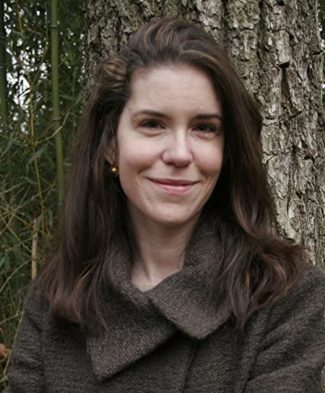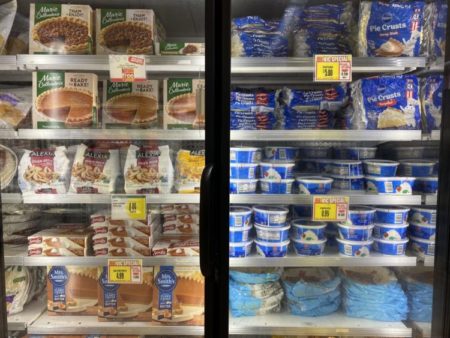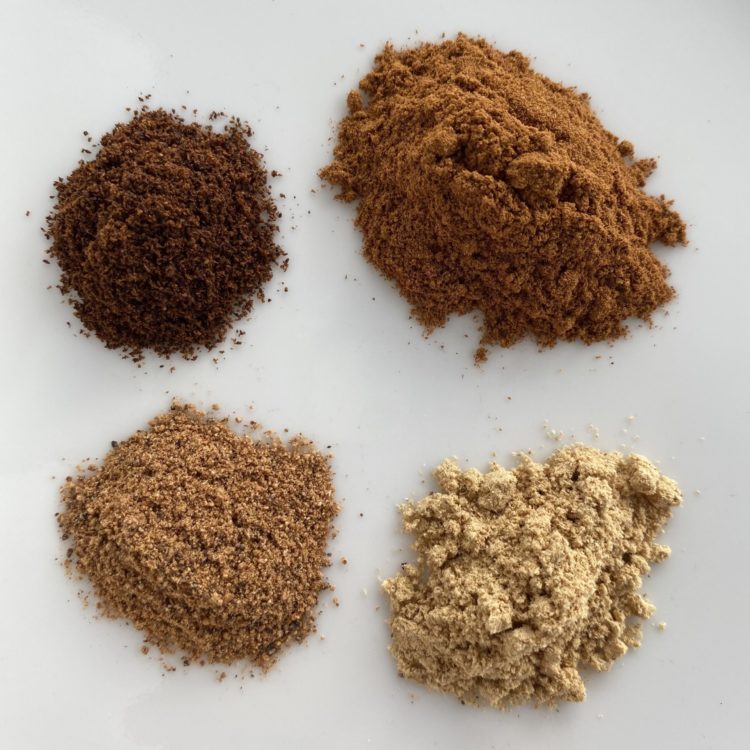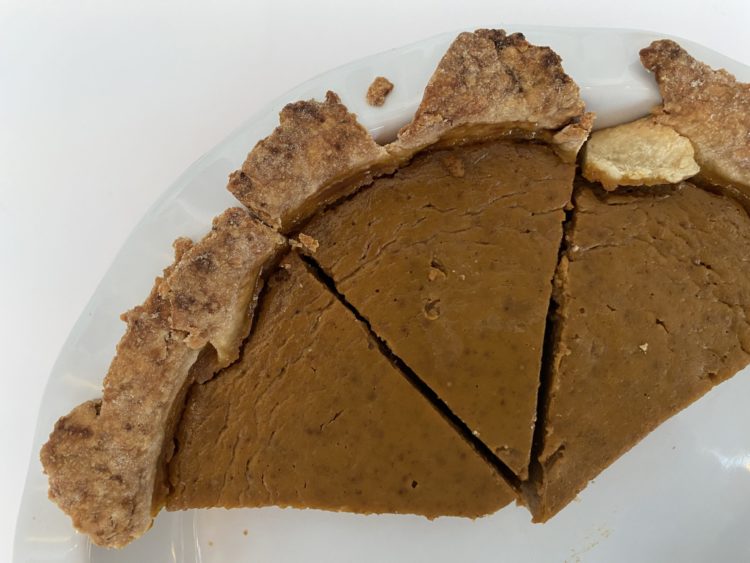EDITOR'S NOTE: This essay is from the archives. If you celebrate American Thanksgiving, I hope it was grand and that you have some leftover pie.
One Saturday morning several years ago, during a substantial storm, my friend and I parted the drapes to enter the sanctuary a warm restaurant. Snow squeaked behind us as the door to the temporary vestibule stopped short of closed. Memories of that day live on my fridge in the form of a postcard that arrived with our bill.
The image of mottled brown paper is blotched with ink: bread, jelly, milk, onions, coal. It was a scan, the owner told me, of an original mid-1800s grocery list found in her family archives.
Family history and food have long intersected, a convergence more visible around the holidays. Each platter and bowl on the table represents a story. That knowledge forms the basis of an essay by Washington Post columnist Megan McArdle, provocatively titled “Can America save its national dish?” with an equally bold subhed: “Americans invented the dessert we call pie. Why are we letting it die?”
McArdle takes us on a delicious journey through history and culture — one she fears we’ll lose in the back of an industrial grocery freezer crowded with ready-made pies and crusts. She opens with a statement that, in her childhood home, “pie was spoken fluently.” Soon enough, she asserts that hers is not a mere bit of memoir:
It is a polemic. I want to convince you that American pie is special, because it is. American pie is great, in part, because of its rich, unlikely history. But American pie is also in dire straits, because American cooks have mostly forgotten how to make the most important part. Which means that we are at risk of losing not just a dessert, but a little piece of who we are as a country.
Pi(e) Day delay
“Food is memory,” McArdle told me when I spoke with her about why she launched a zealous investigation of dessert. She typically writes about economics, politics, and publicy policy, but “I’ve always been passionate about pie.” More specifically, she said, “it’s pie crust.”

Yet her family techniques of gathering and rolling crust never stuck. So about five years ago, she asked her mom to teach her again. McArdle brought along friends who wanted to learn, and recorded the lesson on video: “I had always made pies with her, but I had never made the pie crust.”
She decided to write about what she learned, both about making pie and about the history she uncovered. Her publication goal: March 14, better known as Pi(e) Day by math proponents, pizza devotees, and dessert enthusiasts.
But that was in 2020, and COVID-19 was declared a national emergency on March 13. McArdle emailed with her editor and the art director: The lighter tone of her essay didn’t feel right for the moment. The piece was bumped again by the summer’s social justice protests, and then again by the coronavirus surge last Thanksgiving.
It finally published this past July, in time for anyone interested in converting their 2021 summer berry pickings into a last course of the first order. Appropriate, as McArdle’s piece makes clear that though pie arrived in America with English settlers, generations of colonists transformed the dessert.
Working with archival sources
Pie in Britain meant savory and most likely meat-filled, McArdle notes. Ben Jonson wrote of “immortal crust” in 1631. His poetic description had nothing to do with a grandmother passing down her knowledge to children and grandchildren. Pie, in that era, was a preservation technique.
Not much changed in the 250 years between Jonson and Mark Twain’s satire of European hotel food. His humorous recipe for pie crust: “Take a sufficiency of water and a sufficiency of flour, and construct a bullet-proof dough.”
McArdle’s essay connects the dots that explain how American bakers established pie as a sweet treat instead. The path includes Harriet Beacher Stowe, the geography of apples, the U.S. Supreme Court, and of course, technological wonders like refrigeration and electric ovens. McArdle also introduces readers to a sampling of the kooky 19th-century arguments (Pie causes alcoholism!) that portrayed the dessert as a public health disaster.
All of this accompanies a sharp explanatory section on the tricks and challenges of conjuring a handmade crust — “not just a vehicle for filling but a delight itself,” she writes.

McArdle comes from a family of pie makers, but my baking lineage centers on cookies. Several aunts earned my loyalty with assorted shapes and sizes of sugary crumbles. My pie obsession likely started when pie paired with my favorite season. Each summer, my family would trek to northeast Wisconsin for a week, and tart cherry pie would finish every dinner.
McArdle and I took different paths to the dessert table, but we talked about how an essay on baking can offer lessons for reporting and writing effective stories regardless of beat or subject: working with archival sources and better tuning our eyes to the story leads around us, sometimes quite near.
Given the range of text materials she compiled, I asked her how she chose what to leave out of her essay and what to use from the vast available troves.
“I ended up with a huge number of quotes,” she said. “I picked the ones that were the most germane. What is the best one to illustrate this thing? What is the interesting money-quote that readers won’t have heard before?”
We all search for a succinct illumination, a description said better and with more emotion than we could paraphrase. That’s true whether we peel notebook pages from an interview with a mayor or high-school athlete or scroll through thousands of PDF images. McArdle sifted through a whole roster of historical cookbooks hosted at Michigan State University. “I just downloaded everything from Amelia Simmons through 1900,” she said.
Like the community members we spend time with for our stories, archival sources — maps, photos, books, data — tend to provide more material than we need for any single story. And identifying foundational superlatives for readers can apply across many types of story subjects. “You’re always going to mention the first American cookbook,” McArdle said of Simmons’s 1796 text. “But I could not read everything ever written on pie.”
The basic recipe from Simmons’s cookbook included in two variations is the same that sneaked through the hysteria of the health reformers: pumpkin pie. That realization in my own reading spurred me to immerse myself in pie history.
Surprises for you and the reader
If we claim any pie under the banner of American exceptionalism, the flag should be planted in the whipped topping that crowns a pumpkin pie at Thanksgiving. Pumpkins, after all, are native to North America. Apples, not so much.
“The day after Thanksgiving is the day of eating pumpkin and apple pie for breakfast,” McArdle said.
We can thank Sarah Josepha Hale for that connection. As the editor of a prominent monthly magazine, Hale campaigned with her pen for decades, beginning with an 1827 novel that included a lengthy description of a Thanksgiving meal where “pumpkin pie occupied the most distinguished niche” on the side table, “an indispensable part of a good and true Yankee Thanksgiving.”
The regional intensity of the origins of American pie amazed McArdle. “I hadn’t realized that New England ended up writing the history of America because they were so economically and culturally dominant,” she said. “That really shows in pie. It’s not that no one else does it, but New England does it more than anyone else.”
Her comment was a useful reminder that when we are surprised to learn something about the world around us, odds are that the observation will also surprise our readers.
Consider the 1844 children’s rhyme about traveling to grandmother’s house. The poem is based on the family memories of Lydia Maria Child, who galloped to her grandfather’s house, still located near the Mystic River outside Boston. Despite the white and drifted snow, the poem celebrates Thanksgiving, not Christmas. The final verse:
Over the river, and through the wood—
Now grandmother’s cap I spy!
Hurra for the fun!
Is the pudding done?
Hurra for the pumpkin pie!
Editor Hale continued to lobby for Thanksgiving as a national holiday, then mostly marked in New England. She included an appeal in the September 1863 issue of her magazine and mailed a letter to President Abraham Lincoln. Less than a week after receiving it, with the United States still in the grips of the Civil War, Lincoln signed a proclamation for the whole nation to give thanks “with one heart and one voice.”
The allure of pumpkin pie endured after the war, when the dietary crusaders pounced, exemplified by Sarah Tyson Rorer. In her 1886 chapter on “Pastry and Pies,” she advocated for fine flour and “none but the best butter” to make a crisp and flaky crust. “Have everything, including yourself, cool.”
Still pertinent advice, but the modern marvel of ice does help when you’re mixing the flour and butter into dough. Rorer’s tone changed by 1902. “All forms of so-called pie crust are to be condemned.” The chapter, then renamed “Pastry,” shrank to a scant three recipes we might recognize as pie with a proper bottom crust — but pumpkin persisted.
Good pie and good journalism
As I read McArdle’s essay last week, I studied one of the photos published with it. In the background, a recipe for pumpkin pie is printed in a careful hand, graced by a papery corn stalk border and a dappled blue watercolor background. The framed recipe hangs in McArdle’s mother’s kitchen. As the story goes, McArdle’s mother would call her own mother every Thanksgiving to remind her how to make the crowd-pleaser.
“It has become much more than a recipe,” McArdle said. “It’s a physical piece of family history, and unlike the pies themselves, not ephemeral.”

When I consider the magic of archives, I often think of family archives, of attics and closets so incredibly bountiful but commonly overlooked or unconsidered. Archival sources don’t need to be housed on the climate-controlled shelves of a public institution.
With that in mind, I brushed by the 1800s grocery list as I opened my fridge to assess what I needed to to bake a version of the McArdle family recipe. At the grocery store, I pushed a cart past piles of frozen pie shells and stacks of frosty boxes that promised “THAW & ENJOY!”
I thought of a passage from McArdle’s essay:
Every time families make those choices, they break a chain that had stretched across centuries, from mother to daughter and oven to oven. And reknitting the links is exceedingly difficult, because the children and grandchildren of those who incrementally abandoned pie don’t even know what to aim for.
I’m thankful to have some family experience with that North Star.
Back from the store, my favorite cookbook provided a refresher for a simple crust, and I set about whisking flour, mashing butter with my fingertips, dribbling ice water. In another bowl, I swapped brown sugar for the standard granulated and filled the small space of my kitchen with aromas of earthy cloves and citrusy ginger.
McArdle’s essay points to how much we have forgotten about the history of our national dessert and the skills of making it. But like the process of pie, the process of journalism is learned, McArdle said.
Inverting that idea a bit, an exceptional story — like a memorable pie — invokes at various points our full humanity: sight, sound, smell, touch—and of course, taste.
***
Dustin Renwick is a story editor for National Geographic Live and a journalist who focuses on stories about science, sports, and history, especially from the Midwest and Great Lakes. He writes a short monthly newsletter called Archival Magic.



